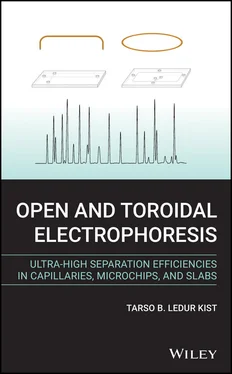The categorization of the dozens of electrokinetic separation techniques (ESTs) is highly necessary as they have important theoretical and practical differences. Consequently, the categorization of these techniques into three levels is proposed as it produces a simple and practical nomenclature. This categorization begins with the first level: the layout of the separation path, which can be either open (O) or toroidal (T) in shape (as previously described).
The second level of categorization is the platform where the ESTs are performed. Capillary (C), microchip (M) and slab (S) platforms are the most common. Flexible fused-silica microtubes, popularly known as capillaries, are already widely used to achieve high separation efficiencies in the open layout and are also starting to be used in the toroidal layout. Cylindrical capillaries are the most frequently used, but square and rectangular capillaries are also available. In the case of microchips, microchannels are etched onto slides of polymeric materials, glasses, fused silica (amorphous), and quartz (crystalline). They show great promise for the development of novel, multifunctional microstructures. The use of 3D printing allows an even larger number of techniques to be performed on this platform, both for basic research and an uncountable number of applications. The slab platform is normally made of a slab of gel, cellulose acetate, nylon membrane, or another porous substance. These macroscopic supports always have an anti-convective effect that prevents the sample from spreading due to convection. In addition, they usually play additional, well established, roles in the separation mechanisms.
The third and lowest level of categorization is the separation mode . This refers to the underlying molecular mechanism used to promote the separation of the analytes of interest, both among themselves and from any undesired sample interferant. The modes include affinity electrophoresis (AE), electrochromatography (EC), end-labeled free-solution electrophoresis (ELFSE), free-solution electrophoresis (FSE), isoelectric focusing (IEF), isotachophoresis (ITP), microemulsion electrokinetic chromatography (MEEKC), micellar electrokinetic chromatography (MEKC), and sieving electrophoresis (SE), to mention only a few. It is interesting to note that this nomenclature is currently normally used for the separation modes, as a result of the recommendations made by IUPAC.
When combining these three levels of categorization to accurately name, produce an acrynom, and describe an EST, the following intuitive rules are proposed: (1) the first word represents the first level of categorization; either open (O) or toroidal (T). (2) The second word specifies the platform: capillary (C), microchip (M), or slab (S). (3) The last word specifies the separation mode. A summary of the ESTs covered in this book is given in alphabetical order in the following table using this proposed nomenclature.
| Layout |
Platform |
Separation mode |
| (1) Open |
(1) Capillary |
(1) Affinity electrophoresis |
| (2) Toroidal |
(2) Microchip |
(2) Electrochromatography |
|
(3) Slab |
(3) End-labeled free-solution electrophoresis |
|
|
(4) Free-solution electrophoresis |
|
|
(5) Isoelectric focusing |
|
|
(6) Isotachophoresis |
|
|
(7) Microemulsion electrokinetic chromatography |
|
|
(8) Micellar electrokinetic chromatography |
|
|
(9) Sieving electrophoresis |
The full names and acronyms of these 54 combinations are presented in Appendix A. However, the feasibility of some of these techniques is not obvious. For instance, running the isotachophoresis mode in the toroidal layout may be difficult because the leading and terminating electrolytes must be exchanged before each high voltage rotation (see Chapter 6).
Free flow electrophoresis (FFE) is a special layout mainly used for preparative separations in special macro- and microchip platforms (shallow two-dimensional chambers). Many separation modes can be performed in this setup. The sample is continuously fed as a narrow streak into the stream of the separation medium and an electric field is orthogonally applied to this flow direction, driving the components of interest to specific collection points of the outlet. This is also discussed in Appendix A.
It must be remembered that, for some applications, gel slabs can be used for at least two purposes; merely as an anticonvective agent (to prevent band spreading) and/or as a sieving agent. In the latter case a high rate of analyte collisions against the polymer net is observed and plays a fundamental role in the separations. All of these techniques and their respective underlying phenomena are discussed in relation to the open and toroidal layouts throughout this book.
Electrophoresis and electroosmosis are the most commonly used phenomena that drive separations in the ESTs. Moreover, a large quantity of additional basic phenomena can be directly observed and studied in the many ESTs. Some examples of these additional phenomena include fluid flow, analyte adsorption, phase partitioning, and the degree of acid–base ionization, as well as the interactions of ion–ion, ion–molecule, target–ligand, antibody–antigen, and many others. Moreover, the quantity of phenomena that can be mathematically modeled using well established theories is remarkable. Most of these phenomena can be modeled from first principles, without the need to add empirical or ad hoc parameters. Even so, as in all areas of science, there are a few experimental observations for which good models do not currently exist, and some of them even lack an adequate theory. It is an interesting field for developing models, testing theories, making predictions, and testing hypotheses involving quantifiable predictions and measurements. Finally, but no less importantly, the resulting separation techniques have an impressive number of applications within diverse fields such as clinical analysis, pharmaceutical analysis, genetic analysis, food analysis, environmental analysis, and proteome analysis, to mention only a few.
The present book is written in such a way as to – hopefully – make it an interesting read for experts in the field as well as for users of these technologies, non-specialists, and students. The whole book is richly illustrated and presents a large number of very useful equations showing the relationships between important operational parameters and other fundamental variables. These are important tools for both readers who are interested in the theories of the field and those who are interested in the practical applications of the ESTs. Mathematical deductions are shown only in the appendices because the intent is not to bother readers who are not very familiar with mathematical methods. Students interested in becoming familiar with the modeling of the electrokinetic phenomena are encouraged to read these appendixes.
In Chapter 1the fundamental concepts and definitions related to liquids that may contain a background electrolyte are reviewed, paying specific attention to their applications to the ESTs. Phenomena and definitions studied in this chapter include the relative permittivity of water, dissolution, solvation, dissociation, ionization, Gibbs free energy, ionization constants, both  -pH and p
-pH and p  -pH diagrams, the Henderson–Hasselbalch equation, and the buffer capacity of aqueous solutions.
-pH diagrams, the Henderson–Hasselbalch equation, and the buffer capacity of aqueous solutions.
Читать дальше

 -pH and p
-pH and p  -pH diagrams, the Henderson–Hasselbalch equation, and the buffer capacity of aqueous solutions.
-pH diagrams, the Henderson–Hasselbalch equation, and the buffer capacity of aqueous solutions.










